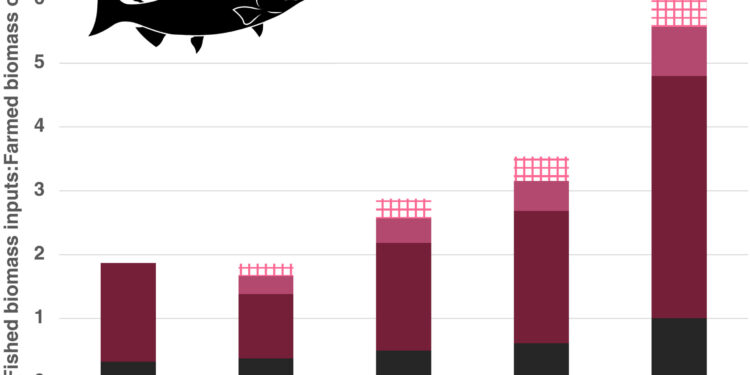Biomass ratios of wild fish mortality to farmed fishery products (FI:FO) for salmon farming, delineated by cause and replicated using four different datasets. Credit: Scientific advances (2024). DOI: 10.1126/sciadv.adn9698
A study published in the journal Scientific advances suggests that global fish farming, or aquaculture, may rely on much larger quantities of wild-caught marine fish than previously calculated. The study is part of a special issue focused on expanding the aquaculture industry’s contributions to food systems with a focus on sustainability.
These results challenge long-held assumptions about the sustainability of the rapidly growing aquaculture industry and provide a range of plausible estimates of its impact on wild fish populations.
The research, led by an international team of scientists from the Rosenstiel School of Marine, Atmospheric and Earth Sciences at the University of Miami, Oceana and New York University, offers a reassessment of “fish-in: fish-out” (FI:FO) for fed aquaculture globally – a key metric used to assess the efficiency and sustainability of aquaculture.
The results indicate that the ratio of wild fish intake to farmed fish production is 27% to 307% higher than previous estimates, ranging from 0.36 to 1.15, compared to an earlier estimate of only 0.28. If we take into account the mortality of wild fish during capture and exclude unfed aquaculture systems, the ratio increases even further: 0.57 to 1.78. For farmed carnivorous species in particular, such as salmon, trout, and eel, wild fish inputs likely exceeded twice the farmed fish biomass produced.
“Our study reveals that the aquaculture industry relies more on wild fish extraction than previous research suggested,” said Spencer Roberts, a doctoral student in the Rosenstiel School in the Department of Environmental Science and Policy and lead author of the paper. ‘study. “This demonstrates the scale to which aquaculture could impact marine ecosystems.”
The research team’s approach included considering previously overlooked wild fish sources in aquaculture feeds, such as wild fish trimmings and by-products. They also included collateral fishing mortality, including “slippage” – a practice where unwanted catches are released but a large proportion of animals often do not survive. By analyzing multiple industry-reported data sets, the team provided a range of estimates and highlighted uncertainties in current reporting practices.
“This research shows that the assumptions we have made about carnivorous aquaculture have been overly optimistic and provides further reason to think strategically about the types of aquatic species that make the most sense to mass produce,” he said. said Jennifer Jacquet, co-author of the study and professor in the Department of Environmental Science and Policy at the Rosenstiel School
The study also examined the environmental trade-offs involved in reducing the use of wild fish in aquaculture feed. The researchers found that widely cited estimates of the decline in wild fish use between 1997 and 2017 would require a five-fold increase in land-based crop use over the same period.
Patricia Majluf, Ph.D., senior scientist at Oceana in Peru, home to the world’s largest fishmeal fishery, notes that the increasing use of byproducts and trimmings has not phased out capture and the use of whole wild fish. fish in aquaculture feed.
“The offshore aquaculture industry is growing so rapidly that wild-caught fish are not being replaced in their diet. Instead, other food sources only supplement the use of wild fish,” says Majluf.
The findings have significant implications for policymakers, investors and consumers. The study calls for more comprehensive and transparent reporting of feed ingredients in the aquaculture industry and suggests that policies favoring the expansion of aquaculture for sustainability reasons be reconsidered.
Matthew Hayek, assistant professor in the Department of Environmental Studies at New York University and corresponding author of the study, said: “It is crucial that we have a more complete understanding of the industry’s impact on marine and terrestrial ecosystems and that we reduce these uncertainties. »
He points out that even with the wide ranges of uncertainty reported, the impacts are still greater than previously reported, and “most offshore finfish aquaculture facilities produce carnivorous fish and are therefore responsible for the depletion of many more more fish from the ocean than they can produce.
The researchers emphasize that while their study provides a more comprehensive view of aquaculture’s environmental impacts, more research is needed to fully understand the sector’s effects on issues such as nutrient pollution, habitat destruction and the spread of disease to wild fish populations.
As demand for seafood continues to grow around the world, these findings highlight the urgent need for greater transparency in fish farming.
More information:
Spencer Roberts et al, Feeding Global Aquaculture, Scientific advances (2024). DOI: 10.1126/sciadv.adn9698
Provided by the Rosenstiel School of Marine, Atmospheric and Earth Sciences
Quote: Aquaculture uses far more wild fish than previously estimated, according to a study (October 16, 2024) retrieved October 16, 2024 from
This document is subject to copyright. Except for fair use for private study or research purposes, no part may be reproduced without written permission. The content is provided for informational purposes only.



